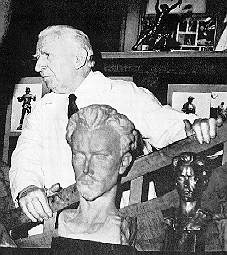KISFALUDI STROBL, Zsigmond
(1884, Alsórajk - 1975, Budapest)


Sculptor. He was a pupil of Lajos Mátrai and Antal Lóránfi at the School of Applied Arts for four years. Meanwhile he worked in the workshop of Alajos Stróbl: he produced two nude sketches in 1904 and 1905. He went to Vienna on a scholarship. On his return to Hungary, Béla Radnai was his master at the School of Industrial Design.
"Finale", a composition with three nude figures from 1911, won him the Radics Prize in 1912 allowing him to go to Italy, France and Belgium. His art was influenced by the esthetics of Adolf Hildebrand, a great German sculptor and theoretician but he made Hildebrand's classic discipline softer, and academism also left its trace on Kisfaludi Strobl's sculpture. As a soldier in World War I, he created portraits. "Archer" from the late 20s reflected Bourdelle's influence.
His art reached its peak in the period between the two world wars. All his works proved his technical skills. His statues and china figures, whether small or larger than life-size, had a dynamism and elegance of their own. That period of his life was marked by countless small bronzes, plaquettes and monumental statues ("War Memorial" in Nagykanizsa, "Prince St. Emeric" in Budapest in 1930) and study trips to England and the USA. His highly effective portraits ("Béla Iványi Grünwald", 1924, "Dénes Györgyi" 1923, "G.B. Shaw" 1932, "János Pásztor" 1934, and "Crown Princess Elizabeth of England" 1937), especially the ones - some 50 - completed in Great-Britain brought him fame all over the wold. "General Hamilton" was erected in Aberdeen, Scotland, and "The Birth of Venus" in Santa Barbara, California. "Liberty" on Gellért Hill was created in a remarkably short time in 1947. He produced the main figure of the "Kossuth Memorial" which was erected in front of the Parliament in 1952, and a year later the new figures of Rákóczi and Kossuth for the Millennium Memorial. He was over 80 when he produced a monumental version of "Warriors of the Border", a statuette, which was erected in Eger in 1968. His portraits of "Zoltán Kodály" (1966), "Árpád Szakasits" and "Pál Pátzay" (1967) were also remarkable.
His works are in the collection of the Hungarian National Gallery and the Göcsej Museum, as well as the British Museum, The Hermitage and the Pushkin Museum.
